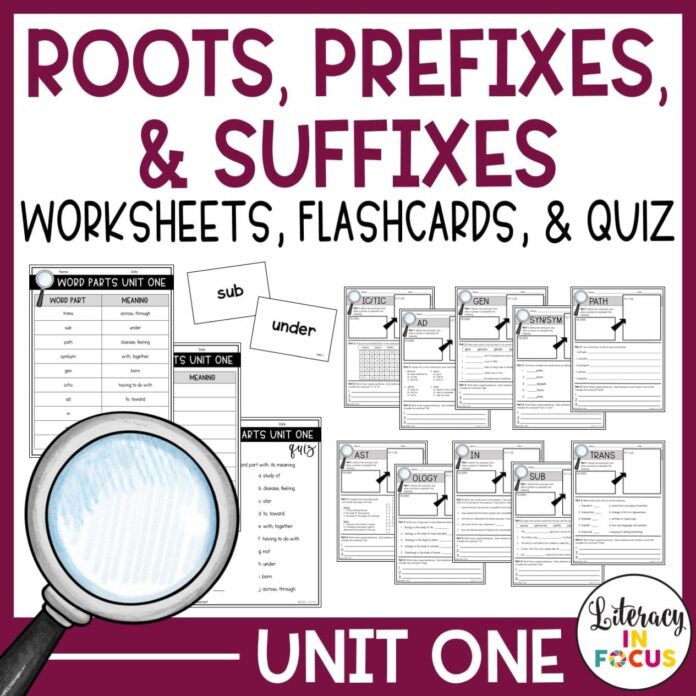
Teaching multisyllabic words with prefixes and suffixes is an important aspect of helping students develop strong reading and vocabulary skills. By understanding how prefixes and suffixes can change the meaning of a word, students can expand their vocabulary and become more confident readers. In this article, we will explore the benefits of teaching multisyllabic words with prefixes and suffixes, as well as some effective strategies for doing so.
Why teach multisyllabic words with prefixes and suffixes?
Multisyllabic words can be challenging for students to decode and understand. By teaching students about prefixes and suffixes, they can learn how to break down these longer words into smaller, more manageable parts. This not only makes it easier for students to read and understand these words, but it also helps them develop a stronger vocabulary.
Understanding the meaning of prefixes and suffixes also allows students to make connections between words. For example, by understanding that the prefix “re-” means “again” or “back,” students can make connections between words like “redo,” “replay,” and “revisit.” This helps students understand the nuances of language and expand their vocabulary.
Teaching multisyllabic words with prefixes and suffixes also promotes critical thinking skills. Students have to think about how the addition of a prefix or suffix changes the meaning of a word, which encourages them to think critically about language and its components.
Effective strategies for teaching multisyllabic words with prefixes and suffixes
1. Introduce common prefixes and suffixes: Start by introducing students to common prefixes and suffixes, such as “un-,” “re-,” “-ful,” and “-less.” Create a list of these prefixes and suffixes and their meanings, and provide examples of words that contain them.
2. Teach word families: Show students how adding a prefix or suffix can create a word family. For example, you can start with the word “happy” and show how adding the suffix “-ness” turns it into “happiness,” or adding the prefix “un-” turns it into “unhappy.”
3. Use visuals and hands-on activities: Visual aids and hands-on activities can help students understand the concept of prefixes and suffixes. You can create flashcards with words that contain prefixes and suffixes, or have students participate in word-building exercises using magnetic letters or word tiles.
4. Practice with word sorts: Word sorts are a great way for students to practice identifying and categorizing words with prefixes and suffixes. Provide students with a list of words and have them sort them based on their prefixes and suffixes.
5. Read and analyze texts: Choose texts that contain multisyllabic words with prefixes and suffixes, and have students read and analyze them. Encourage students to identify and discuss the prefixes and suffixes they encounter, as well as how they change the meaning of the words.
6. Encourage word play: Engage students in word play activities that involve creating new words using prefixes and suffixes. For example, you can have students create silly sentences using words with prefixes and suffixes, or challenge them to come up with as many words as they can by adding different prefixes and suffixes to a base word.
Incorporating multisyllabic words with prefixes and suffixes into the curriculum
When teaching multisyllabic words with prefixes and suffixes, it is important to integrate these concepts into the overall curriculum. Here are some ways to do so:
1. Incorporate multisyllabic words with prefixes and suffixes into vocabulary lessons: Use multisyllabic words with prefixes and suffixes as part of your vocabulary lessons. Introduce students to new words with prefixes and suffixes, and have them practice using these words in sentences.
2. Use multisyllabic words with prefixes and suffixes in reading passages: Select reading passages that contain multisyllabic words with prefixes and suffixes, and use these passages to practice decoding and understanding these words.
3. Create word study activities: Design word study activities that focus specifically on multisyllabic words with prefixes and suffixes. This can include word sorts, word building exercises, and analyzing the meanings of words with prefixes and suffixes.
4. Provide opportunities for independent practice: Give students opportunities to practice identifying and creating words with prefixes and suffixes on their own. This can include worksheets, games, and other independent activities.
By incorporating multisyllabic words with prefixes and suffixes into the curriculum, you can help students develop a deeper understanding of language and expand their vocabulary. This not only helps them become more confident readers, but it also equips them with valuable critical thinking and language skills.
In conclusion, teaching multisyllabic words with prefixes and suffixes is an important aspect of helping students develop strong reading and vocabulary skills. By understanding how prefixes and suffixes can change the meaning of a word, students can expand their vocabulary and become more confident readers. By incorporating multisyllabic words with prefixes and suffixes into the curriculum, using effective strategies for teaching these concepts, and providing opportunities for independent practice, teachers can help students develop a deeper understanding of language and become more proficient readers.


















